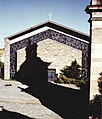Obernau (Aschaffenburg)
|
Obernau
City of Aschaffenburg
Coordinates: 49 ° 56 ′ 0 ″ N , 9 ° 8 ′ 0 ″ E
|
||
|---|---|---|
| Height : | 118 m above sea level NHN | |
| Area : | 8.1 km² | |
| Residents : | 4932 (December 31, 2018) | |
| Population density : | 609 inhabitants / km² | |
| Incorporation : | May 1, 1978 | |
| Postal code : | 63743 | |
| Area code : | 06028 | |
|
Location of Obernau in Bavaria |
||
|
Aerial photo (2008)
|
||
Obernau is a district of the independent city of Aschaffenburg with 4,932 inhabitants (December 31, 2018) and belongs to the administrative district of Lower Franconia in the Free State of Bavaria in the Federal Republic of Germany .
location
The district is on the right side of the Main and borders (in contrast to the illustration "Grobe Stadtgliederung" in the article on Aschaffenburg ) with the building yard of the Aschaffenburg water and shipping office and with its field corridor below the Bischberg , along the Reiterweg and below the Jewish cemetery as well with its forest as far as the area of the Fidelio forest house in the Schweinheim district . In the south, the Altenbach forms the border with the Sulzbach market in the Miltenberg district .
The lowest point of Obernau is the mean reservoir of the Main below the Obernauer Schleuse at 108.5 m above sea level. NN , the highest point is the area of the Judenberg at 206 m above sea level. NN .
history
The oldest original document that has survived, which Obernau calls "Oberenheim" three times, is a deed of donation from Archbishop Konrad I of Mainz to the St. Peter and Alexander monastery in Aschaffenburg from 1191. As early as 1169, a document preserved in copies mentions Obernau as in possession of the Maria Abbey of Mainz in Campis. Pope Lucius III, who arranged the Mainz property in 1184, mentions the parish church of Ruchelnheim , the mother church of the chapel or church in Obernau ( "parrochiam in Ruchil (n) heim" ).
Obernau is much older, however. Early settlement could be proven through the discovery of a fish hook from the late Mesolithic (10,000 to 3,500 BC), stone axes from the Neolithic (3,500 - 2,500 BC) and needles from the Bronze Age (1550 to 750 BC) . Chr.). The most spectacular find was a 42 cm high (mouth diameter 40.5 cm) cylinder neck urn from the Hallstatt period (750 to 450 BC). Further finds up to the 6th century AD are now exhibited in the city museum of Aschaffenburg.
The first written evidence of viticulture in Obernau dates from 1283, and at the same time the first mention of a chapel. Around 1440 the village was fortified with a wall. Since 1486 the Aschaffenburg escort of the Nuremberg and Augsburg merchants led to Frankfurt via Obernau. However, because of the proximity of Aschaffenburg, the place could not draw any financial advantage from it.
In the Turkish tax list of 1551, the oldest surviving record of this kind, Obernau has 52 households, which corresponds to about 260 inhabitants. The village of Obernau appears in 1594 on the so-called Pfinzing-Spessart map (Pfinzing Atlas) as "Obernaw" and is represented with a church tower. The dating of a sandstone, which bears the coat of arms of Mainz Archbishop Wolfgang von Dalberg and which connects the clubs as their common coat of arms, dates from the same year .
Around 1600 the old spelling "Ober (e) nheim" was replaced by the new name Obernau.
In the spring of 1632, the plague killed 171 people in Obernau. The population had fallen to 32 households, around 160 people and 37 stoves.
" St. Peter ad Vincula " ( San Pietro in Vincoli ) this is how the patronage of the Obernau chapel is given in a church invoice from 1656, later with "St. Peter and Paul ”. The chapel, the exact construction of which is not known, but has been documented since 1283, stood in the area of today's village cemetery.
The year 1668 is the oldest known mention of two shield taverns - that of Georg Adam Wirth and that of Johann Gerlach.
The year 1712 bears the lintel of the forest chapel "Maria Frieden". The establishment goes back to a legend about an iniquity.
In 1792 the foundation stone was laid and the old parish church was built by Pastor Philipp Eustach Cammer, after the old parish of Ruchelnheim was dissolved in 1788 and divided into two parishes - Obernau and Sulzbach.
At the end of the Electorate of Mainz in 1803, Obernau belonged to the Schweinheim District Bailiwick of the Vizedomamt Aschaffenburg, both with their seat in Aschaffenburg.
On June 26, 1814, Obernau, like most of the Spessart region , fell to the Kingdom of Bavaria and was incorporated into the Aschaffenburg district court in early 1815.
With the district court of Aschaffenburg, Obernau came to the district office of Aschaffenburg in 1862, which was called the district of Aschaffenburg from 1939 onwards.
In the 19th century Obernau was an important shipping community with viticulture and timber trade. In 1840 four Obernau ships sailed on the Rhine and Main, each with over 1,000 quintals of cargo. Their names were Morgenstern, Sonne, Adler and Phöbus.
The first clubs were founded in Obernau at the end of the 19th century, the oldest being the choral society "Harmonie" (1888), the volunteer fire brigade (1892) and the Catholic workers' association KAB (1895). The Obernauer Vereinsring currently has 29 members.
On May 1, 1921, the expanded “Maria Frieden” chapel was inaugurated in the Obernau Forest. In solemn processions, the Aschaffenburg inner city parishes, Schweinheim, Gailbach, Sulzbach and many private groups move to the Obernau Chapel on the 1st Sunday of May.
From 1926 to 1930 the Obernau barrage and the hydroelectric power station were built. The old lock is to be replaced by a new one from 2020. Commissioning is expected to take place in 2030 and construction work to be completed in 2037.
In the late autumn of 1931, twelve young people from Obernau who were keen on hikers, who were close to nature and who loved their home, came together and founded the “Edelweiss” hiking club.
In the 1930s, a pioneer water training area was built in Obernau on the boundary of Schweinheim. Today the building yard of the Aschaffenburg Waterways and Shipping Office is located there.
On April 1, 1939, the Hinterfeld corridor with approx. 57 hectares of land was removed from the municipality of Schweinheim and incorporated into the municipality of Obernau.
In the two world wars 1914–1918 and 1939–1945, 89 Obernauer lost their lives. Many were missed for a long time.
After the construction of the settlement in 1950, the water and canal construction in the years 1951–1954 and the construction of the new school in 1958, Obernau received a new church in 1960, which was inaugurated in 1962 by Bishop Josef Stangl .
As part of the district and territorial reform , Obernau became a district of Aschaffenburg on May 1, 1978, with 3368 inhabitants and a community area of approx. 813 hectares.
On May 27, 2011, the 2309 state road , which had been moved to the railway line, was opened to traffic. In the course of the construction of this local relief road, three level crossings were replaced by railway bridges in the local area of Obernau.
economy
Obernau includes the building yard of the Aschaffenburg water and shipping authority in the north and a commercial enterprise in the former waterworks of the city of Aschaffenburg as well as the industrial area in the southeast, which is directly adjacent to the municipality of Sulzbach am Main . In the village there is a food market, two beverage markets, several smaller shops and a few restaurants.
Education, culture and leisure
Obernau has its own primary school, a children's house, a Catholic library in the rectory, several clubs, a soccer field, a multi-purpose hall, a glider airfield, good hiking opportunities in the nearby forest and on the Main, various restaurants and good transport links.
Attractions
- Obernau chapel
- Obernau Church
- Obernau vicarage
- Obernau town hall
- Obernauer Geißenbrunnen
- Obernauer Mariengrotte
Joke verse
"In Obernau there the sky is blue, there the billy goat is dancing with his wife." - According to this saying, a goat fountain "Gaasebrunne" was created in Obernau in 1992 in a small green area.
Well-known people from Obernau
- Paul Gerlach (born August 18, 1929 in Obernau; † May 24, 2009 in Aschaffenburg ) was a German lawyer , administrative officer and politician ( CSU ).
- Klaus Herzog (born March 29, 1951 in Obernau) was the acting Lord Mayor of Aschaffenburg from 2000 to 2020.
traffic
Deutsche Bahn
- Aschaffenburg – Miltenberg railway line - course book line 781
- Operator: Deutsche Bahn subsidiary Westfrankenbahn
- Section: Aschaffenburg - Obernburg-Elsenfeld - Miltenberg - Wertheim - Crailsheim
Usually holds once an hour in both directions
Bus routes
- City bus 1 : Aschaffenburg Hbf / Rob - Obernau - Sulzbach
- VAB bus 61 : Aschaffenburg Hbf / Rob - Obernau - Sulzbach - Kleinwallstadt - Elsenfeld - Erlenbach - Klingenberg - Mönchberg
Web links
- Spessartagen - The Obernauer Kapellchen
- The hunger well
- The rescue
- The Obernau hydropower plant
- New lock construction in Obernau
- Club ring Obernau
- Culture trail Obernau
- Geißenbrunnen
- Pictures Obernaus
- List of tombstones in the Obernau village cemetery (Fig.)










